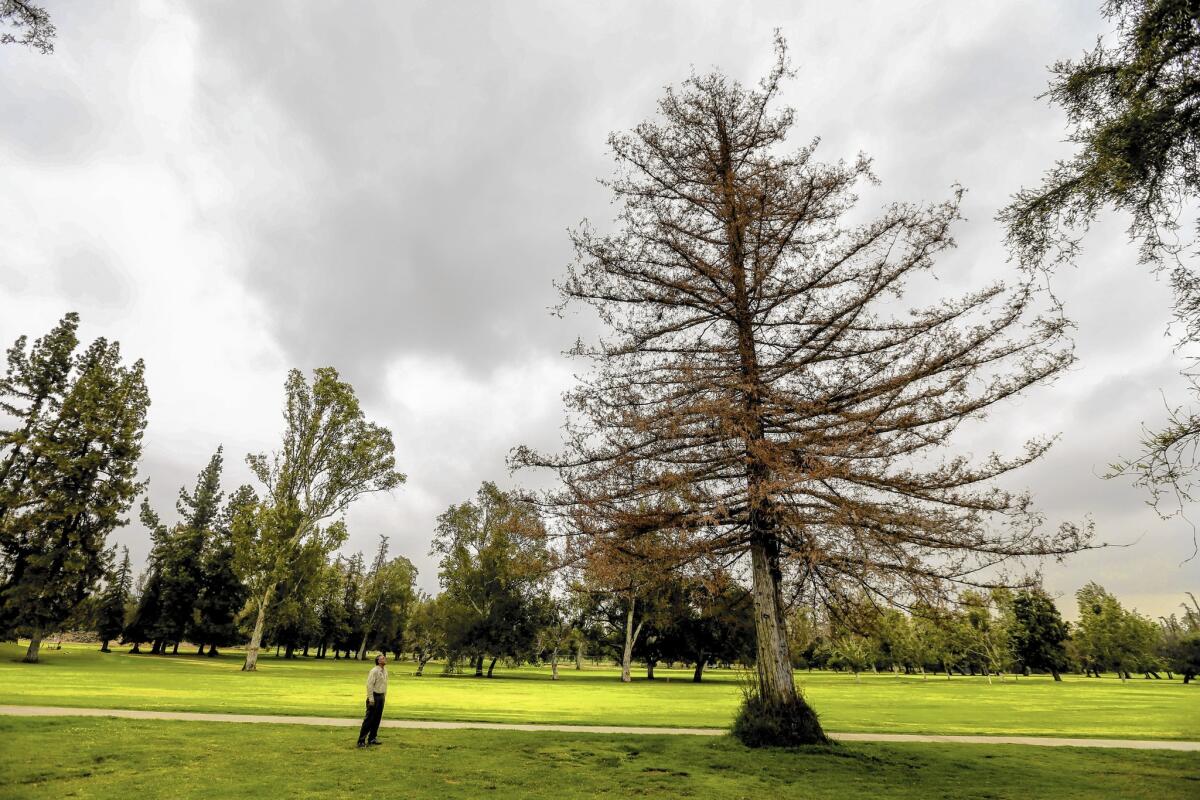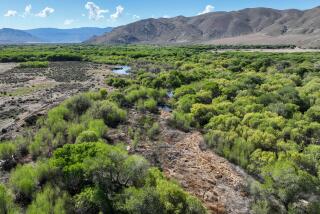Dying trees may force a new outlook on irrigation during drought

- Share via
The needles on the redwoods that welcome visitors to Griffith Park have faded to brown over the last two years. Laura Bauernfeind has watched the trees slowly die and workers eventually arrive, chain saws buzzing, to fell the husks one by one.
“I would be lying if I said it was not disheartening,” said Bauernfeind, principal forester with the Los Angeles Department of Recreation and Parks. “We dedicate our careers here to sustaining our park trees.”
The unrelenting drought that has ravaged parts of California’s forest land is now taking a toll on the trees that line urban parks, boulevards and backyards. From the traffic-clogged streets of L.A. to San Diego’s scenic parks, the trees that locals have come to love are increasingly falling victim to years of hot weather and little rain.
According to a parks department survey ending in April, as many as 14,000 trees in L.A. parks — about 4% of the total — may have died during the last year of drought. The year before that, officials said only about 1% of trees were found dead. In a normal year, the tally would be even less.
Scientists say the death of so many trees could drive up temperatures, wreak havoc on habitats and limit the capture of water. They expect that even more trees could wither as Californians struggle to comply with new conservation rules.
On the bright side, though, scientists say the drought could force homeowners and cities to irrigate more efficiently and replace old, thirsty trees with drought-tolerant ones.
“People really haven’t had to play a role in taking care of the ecosystem around them,” said Andy Lipkis, president of the nonprofit organization TreePeople. “If we’re going to have trees here taking care of us, we have a role to play if they’re going to live. That means learning a little bit, and not causing more damage.”
Park trees across Los Angeles are showing signs of distress and succumbing to the drought, Bauernfeind said. Along urban streets, Lipkis said he sees trees dead or dying “pretty much block by block.” But he said nobody is keeping an exact count. (The city’s urban forestry division, which oversees street trees, did not return calls for comment.)
More than 100 miles south, the drought is hitting trees in San Diego’s Balboa Park. While most of the trees appear in good shape, those in areas not served by irrigation — in steep gullies not used by park visitors, and on the western edge of the park — are in trouble.
“The older trees are struggling,” particularly those dependent on rainwater, said Casey Smith, the park’s district manager.
Last week, city workers were installing irrigation piping near a grove of a dozen Canary Island pines on the western edge.
“We need to save the trees,” said crew leader David Gonzalez. “They’re old, but we need them here for our kids and their kids.”
Balboa Park is a top tourist destination but also serves many locals, particularly from surrounding neighborhoods, who jog or walk their dogs there. Park patrons are worried about how the city can keep the 1,200-acre park green and inviting while following the mandate from Gov. Jerry Brown and state water officials to use less water.
“I’m worried about the park, we’re all worried,” Alessa Goforth said as she walked her two poodles. “Today, it’s not bad, but if things go on, who knows? It wouldn’t be our San Diego without our park.”
Arborists and experts say that tree loss could have dire consequences.
Trees provide shade and help cool the environment, said Stephanie Pincetl, director of the California Center for Sustainable Communities at UCLA. The average park in L.A. is about five degrees cooler than the neighborhood that surrounds it, Bauernfeind said.
Trees also absorb and store rain water that could otherwise cause flooding, Lipkis said. The estimated 350,000 trees in city parks capture more than 360 million gallons of stormwater every year, Bauernfeind said. Collectively, L.A. parks’ tree inventory has a replacement value of $2.2 billion, she said.
“Just like we have to paint City Hall and care for it, we have an obligation to care for this hard-working infrastructure,” Bauernfeind said. “It’s no different than a power line or a sewer line.”
Trees are already getting cut down to make way for homes and businesses, experts said. And new watering restrictions could further compound the problem.
As Californians have turned off their sprinklers to meet conservation mandates in the wake of Brown’s order to cut urban water use by 25%, backyard trees are suffering along with lawns, arborists said.
Trees on street medians may also be at risk because of new drought restrictions that prohibit irrigating turf on public medians with drinkable water.
“The challenge is making sure that the trees and other vegetation that is not turf get sufficient irrigation to stay alive,” said Max Gomberg, the state water board’s senior scientist.
Linda Eremita, forestry education manager at TreePeople, said trees do need water, but the water does not always have to be potable.
For example, La Cañada Flintridge has contracted with neighboring Glendale to buy recycled water for trees in medians.
“Capture rain water, install a graywater system — there’s lots of ways to water trees,” Eremita said. “People think because a tree is so big and established it can’t fail. Well, they are failing.”
Still, the tree deaths may prove instructive, experts said. Californians may turn to more efficient irrigation systems and take the time to learn more about how much water their trees actually need, Pincetl said.
In addition, trees that fall victim to the drought can be replaced with those requiring less water.
“People like greenery and landscape. They don’t know very much about it,” Pincetl said. “So what we have is a set of horticultural practices that are pretty lazy.”
Some trees won’t need replacing. On Santa Cruz Island, where about two-thirds of the Bishop pines appear dead, the trees can regenerate.
Kathryn McEachern, a research ecologist with the U.S. Geological Survey, said the trees’ closed cones fall with them when they die. Heat, either from fire or weather, causes the cones to open and release the seeds. When rain finally arrives, the seeds germinate and eventually new trees grow.
“It’s the cycle of life, and an indicator that we do go through drought periods that affect plants,” McEachern said. “But it’s pretty cool that they actually have a mechanism to come back.”
matt.stevens@latimes.com
Twitter: @bymattstevens
taylor.goldenstein@latimes.com
Twitter: @taygoldenstein
tony.perry@latimes.com
Twitter: @LATsandiego
Stevens and Goldenstein reported from Los Angeles, Perry from San Diego.
More to Read
Sign up for Essential California
The most important California stories and recommendations in your inbox every morning.
You may occasionally receive promotional content from the Los Angeles Times.











